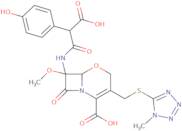(6R,7R)-3-(Hydroxymethyl)-7-(2-(4-hydroxyphenyl)acetamido)-7-methoxy-8-oxo-5-oxa-1-azabicyclo[4.2.0]oct-2-ene-2-carboxylic acid
CAS: 64952-97-2
Rif. 3D-PCA95297
| 1mg | Fuori produzione | ||
| 5mg | Fuori produzione | ||
| 10mg | Fuori produzione | ||
| 25mg | Fuori produzione | ||
| 50mg | Fuori produzione |
Informazioni sul prodotto
- (6R,7R)-7-[[(2R)-2-Carboxy-2-(4-hydroxyphenyl)acetyl]amino]-7-methoxy-3-[[(1-methyl-1H-tetrazol-5-yl)thio]methyl]-8-oxo-5-oxa-1-azabicyclo[4.2.0]oct-2-ene-2-carboxylic acid
- (6R,7R)-7-{[carboxy(4-hydroxyphenyl)acetyl]amino}-7-methoxy-3-{[(1-methyl-1H-tetrazol-5-yl)sulfanyl]methyl}-8-oxo-5-oxa-1-azabicyclo[4.2.0]oct-2-ene-2-carboxylic acid
- 5-Oxa-1-Azabicyclo(4.2.0)Oct-2-Ene-2-Carboxylicacid,7-((Carboxy(4-Hydroxyphen
- 5-Oxa-1-azabicyclo[4.2.0]oct-2-ene-2-carboxylic acid, 7-[[(2R)-2-carboxy-2-(4-hydroxyphenyl)acetyl]amino]-7-methoxy-3-[[(1-methyl-1H-tetrazol-5-yl)thio]methyl]-8-oxo-, (6R,7R)-
- 5-Oxa-1-azabicyclo[4.2.0]oct-2-ene-2-carboxylic acid, 7-[[(2R)-carboxy(4-hydroxyphenyl)acetyl]amino]-7-methoxy-3-[[(1-methyl-1H-tetrazol-5-yl)thio]methyl]-8-oxo-, (6R,7R)-
- 5-Oxa-1-azabicyclo[4.2.0]oct-2-ene-2-carboxylic acid, 7-[[(2R)-carboxy(4-hydroxyphenyl)acetyl]amino]-7-methoxy-3-[[(1-methyl-1H-tetrazol-5-yl)thio]methyl]-8-oxo-, (6R,7R)- (9CI)
- 5-Oxa-1-azabicyclo[4.2.0]oct-2-ene-2-carboxylic acid, 7-[[carboxy(4-hydroxyphenyl)acetyl]amino]-7-methoxy-3-[[(1-methyl-1H-tetrazol-5-yl)thio]methyl]-8-oxo-, [6R-[6a,7a,7(R*)]]-
- 7-((Carboxy(4-hydroxyphenyl)acetyl)amino)-7-methoxy-(3-((1-methyl-1H-tetrazol-5-yl)thio)methyl)-8-oxo-5-oxa-1-azabicyclo[4.2.0]oct-2-ene-2-carboxylic acid
- Lamoxactam
- Moxalactam
- Vedi altri sinonimi
- Moxam
- Oxa-cephem
- Yl)Acetyl)Amino)-7-Methoxy-3-(((1-Methyl-1H-Tetrazol-5-Yl)Thio)Methyl)-8-Oxo-
Azithromycin is a macrolide antibiotic that is used to treat bacterial infections. Azithromycin can be found in the blood and tissues of pregnant women, which may be due to its ability to cross the placenta. Azithromycin is not active against Gram-positive bacteria and therefore should not be used as monotherapy for infections caused by these types of bacteria. Azithromycin has been shown to be active against many strains of Gram-negative bacteria, including Enterobacteriaceae, Neisseria gonorrhoeae, Chlamydia trachomatis, Helicobacter pylori, Legionella pneumophila, Mycoplasma pneumoniae and Borrelia burgdorferi. The antimicrobial activity of azithromycin results from inhibition of microbial protein synthesis through binding at the ribosome. This drug binds to bacterial ribosomes and blocks peptide bond formation by interfering with the binding site for erythromycin on





